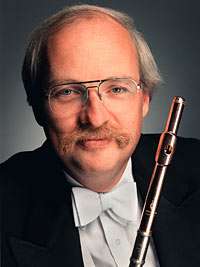|
Back
The Exclamation Point of Contact! New York
Grace Rainey Rogers Auditorium, Metropolitan Museum of Art
06/08/2012 - & June 9, 2012
Contact!
Elliott Carter: Two Controversies and a Conversation (World Premiere)
Michael Jarrell: Nachlese Vb Liederzyklus: A Musical Mediation on the Nature of Linguistic Translation (World Premiere)
Pierre Boulez: ...explosante-fixe...
Colin Currie (Percussion), Eric Huebner (Piano), Charlotte Dobbs (Soprano), Robert Langevin (MIDI flute), Mindy Kaufman, Alexandra Sopp (Flutes, John Schaefer (Interlocutor), Magnus Lindberg (Commentator)
Members of the New York Philharmonic Orchestra, David Robertson (Conductor)

E. Carter (© Cory Weaver/92StY)
The reason why the New York Philharmonic series “Contact!” has an exclamation point became obvious 10 seconds past the starting time of 7pm.
That sagacious writer/interviewer John Schaefer on the massive stage in the Metropolitan Museum of Art Grace Rainey Rogers Auditorium introduced “young man” Elliott Carter. The youngster did use a wheelchair, but when the 103-year-old composer started speaking about his compositions, his premieres, and an admission that his music was perhaps even better since the age of 90, the exclamation point on Contact! began jumping.
This was only a beginning for a series which–for its musical-elite attendees, the grandiose setting, and, above all, the music–could only be compared to those Viennese-Parisian salons of the 1920, when Schoenberg, Ravel, Martinù, Berg and Stravinsky etc etc etc would come together for their own music.
Were those musicians as accomplished as those of last night? Perhaps, but the New York Philharmonic ensemble and the splendid soloists would do credit for any era The fact that two of the composers were interviewed, shedding light on their work, and that conductor David Robertson offered an especially illuminating anecdote on Pierre Boulez, added to the luster of the occasion.
More than luster, those in the audience felt they were part of a very special occasion.
And the music itself? For the first initial work, Two Controversies and a Conversation (New York Philharmonic Orchestra co-commission with Aldeburgh Festival and Radio France), Elliott Carter not only stayed away from even the slightest indication of age, but this was a jolly, complex, and transparent homage to–don’t even try to guess!!–to the art of Jazz “cutting.” Mr. Carter’s does not take easily to jazz, but the improvisational forms where two instruments competed to outdo each other was alive and well.
Those were the two “controversies.” Percussionist Colin Currie doubtless lost a few pounds as he ran around marimba and xylophone, gongs and snare-drums and timpani, as he vied with pianist Eric Huebner in turning melody into rhythm and vice-versa. The second movement highlighted Mr. Huebner, and the final “conversation” brought the orchestra fully into the schematics.
The work was less than 10 minutes long, but the number of notes was staggering. Those, though, were the tools. It was even more evident that Mr. Carter enjoyed writing this delicious work–as well as standing up in the audience in appreciation of these fine musicians.
The final two works dealt with translations and/or transubstantiations.
The Swiss composer Michael Jarrell has his orchestral sensibilities as delicate and sensitive as his countryman Frank Martin. The subtitle to the tongue-mangling Nachlese Vb Liederzyklus (New York Philharmonic co-commission with Ensemble Contrechamps) is a mind-mangling “A Musical Mediation on the Nature of Linguistic Translation.” But the premise was simple. He took a 16th Century poem Spanish poem by Luis de Góngora y Argote and set it to musica long with a French and German translation in music. The catch was that the work, like, say, Finnegans Wake in our own time, is untranslatable, filled with neologisms, puns, surrealistic images etc.
Yet it was indeed translated, and Charlotte Dobb used the lines not for illustration but as background to the delicate orchestration. The original French translation was offered in lines at the extremes of the soprano’s considerable range, the German was more dramatic-operatic and the original Spanish was a euphoric reading, with a purely musical maelstrom in between. It was a beguiling work, worthy of a second...or third hearing, if only for Mr. Jarrell’s mastery of the orchestra.
That was translation. The longest work was less a translation of Stravinsky than a Eucharist, a transubstantiation of Stravinsky from the mind of Pierre Boulez. Mr. Robertson had related how on a plane trip together, the composer had stayed up all night, fascinated by the clouds, the plane lights, the slightest cosmic changes outside the window. If that didn’t literally explain Boulez’s paean on the death of Stravinsky, ...explosante-fixe..., it gave an indication to the Boulez mind in action.

R. Langevin (© Chris Lee/NY Philharmonic)
This work, though, highlighted by Robert Langevin and the computerized MIDI flute, and two other flutists, was like a ceremony Lights dimmed at times, violin and violist stood until the last moments, the three flutes played constantly.
Was it my imagination? Or did I detect measures from Firebird, Sacre, Symphonies of Wind Instruments transmuted to the Boulez mind. Mr. Robertson explained that Boulez here was attempting each measure to be interesting in itself, without any indication on what the following movements would be.
Granted, the aural tapestry of nonending twittering flutes was not to everybody’s liking, but the performances were quite brilliant, and Mr. Robertson conducted all three works with his usual expertise and aplomb.
Harry Rolnick
|